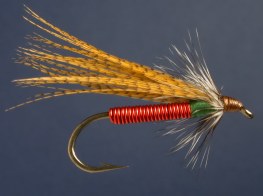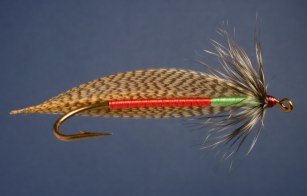Invicta Flies - Eighty-Eight
Thanks to Alberto Jimeno of New Hampshire for sharing this pattern with us.
From the Sebago Lake area of Maine comes this classic example of simple elegance. Commonly known as a flatwing pattern (the wing lays flat along the top rather than upright), it can be altered a little to change its shape and action. Different hook styles can vary the length and subsequently the proportions, and using a bundle of the wood duck fibers rather than the feather tip will give you a fuller, "meatier" imitation. In addition, floss is often substituted for the wire on on the body for a slightly different look and lighter pattern. See notes below for fishing technique.
 Bundled wing on standard streamer hook. Fly: Albert Jimeno.
|
 Flatwing version, long-shank hook, viewed from underneath.
|
Hook: Mustad 3665A, #6-12, or other standard streamer hook
Thread: Uni-Thread 6/0, brown
Body: rear two-thirds fine red wire; front one third fine green wire
(or substitute floss)
Wing: wood duck flank
Collar: grizzly hen hackle
Head: tying thread
Tying Instructions:
1) Secure thread to hook just behind the eye and wind back one third of the shank. Tie in the tag end of the red wire and lash it to the top of the shank all the way to the bend. Wind the thread forward again to the tie-in point. Wrap the wire forward in touching turns two thirds up the shank (to the tying thread), tie off, and clip the excess. NOTE: if using floss instead of wire, lay a thread foundation along the entire shank, tie the floss in one third of the shank behind the eye, wrap it to the bend, then back up to the thread to tie off.
2) Lash the tag end of the green wire to the top of the shank from the red portion forward to about one and a half hook eye widths behind the eye. Wrap the wire forward in touching turns to the thread, tie off, and clip the excess. NOTE: if using the floss, after tying off the red, advance the thread to one and a half hook eye widths behind the eye, tie in the tag end of the floss, wrap back to the red, then forward again to the thread and tie off.
3) For the flatwing version, select a well-marked wood duck flank feather or substitute with somewhat long fibers. Measure against the hook and trim the tip from the feather so it is as long as the hook plus the hook gap. Strip several bottom (butt end) fibers from each side and flatten this portion of the stem with fine, smooth pliers so it will lay flay when tied in. Tie this in on top of the hook so the feather is pependicular to the hook.
4) Select a hen hackle feather with fibers about one and a half times as long as the hook gap. Fold the fibers backside to backside, and tie the feather in by the tip. Take two full turns of the hackle, tie off, and clip the excess. Stroking the fibers rearward as you wraps helps lay them back a bit.
5) Build up a smooth, tapered head with the tying thread, whip finish, clip, and cement well for a glossy look.
NOTES: Alberto has this to say on fishing the Eighty-Eight: "...where its has proven it's worth to me is when I'm fishing for river smallies or panfish. Being a heavy fly it has no trouble getting down so what I do is halfway through the downstream swing I swim the fly upstream with short, fast, erratic movements. I don't feed or strip in any line, I just pump my rod hand upstream for a short distance. This makes the streamer rise from the bottom in a jerky fashion. The strikes are hard and the fish usually hook themselves. After making one short upstream swim, I let the fly keep on swinging downstream and I repeat this a couple more times."